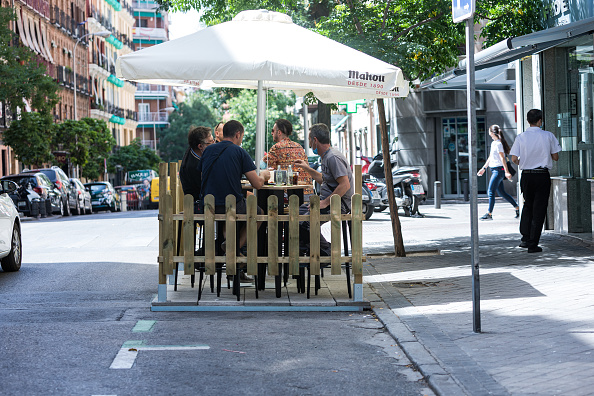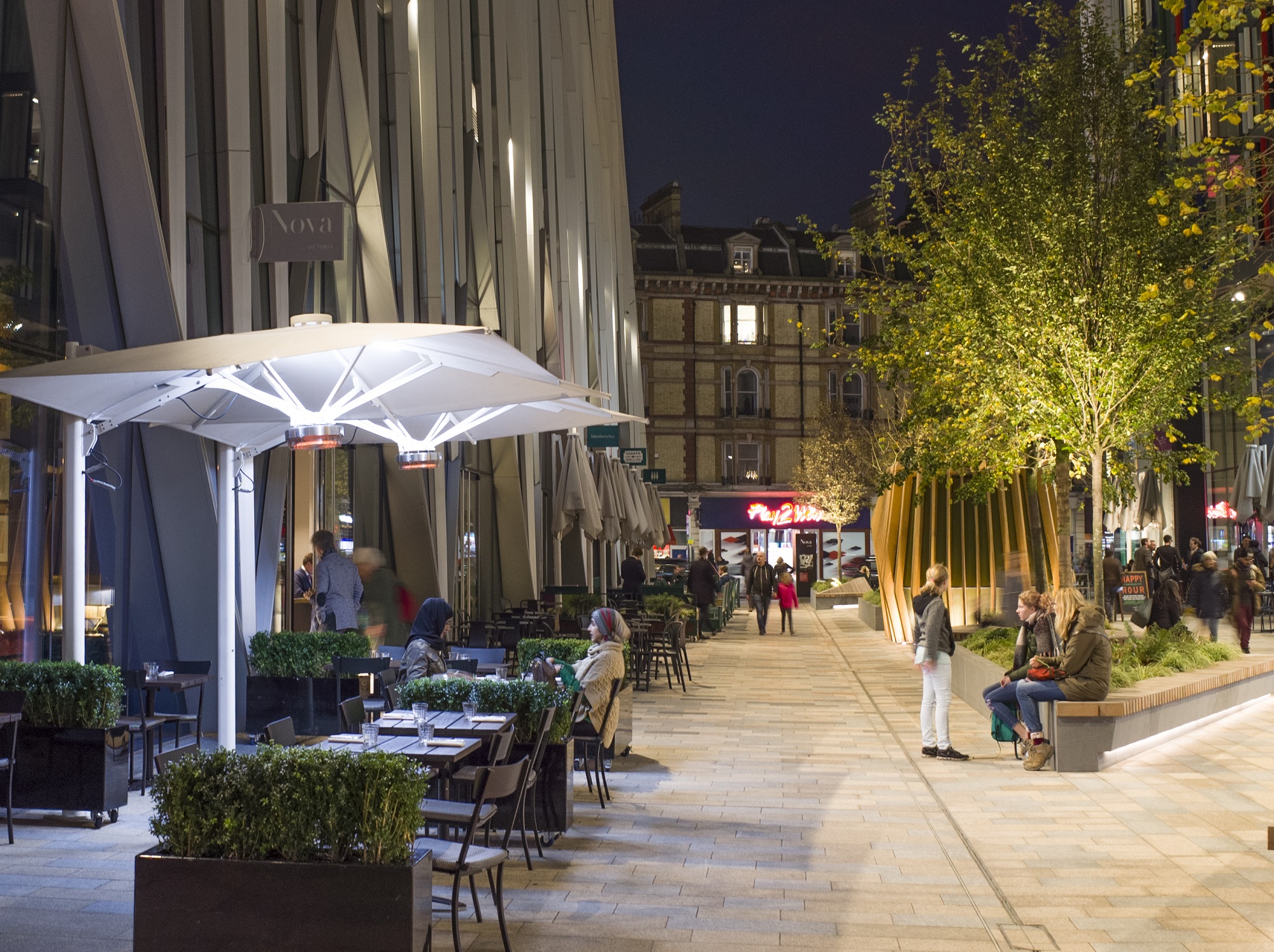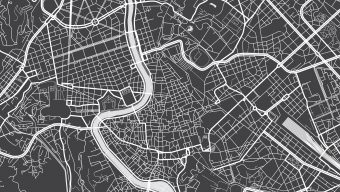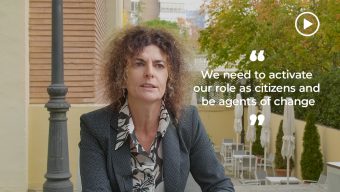Nova Victoria, a mixed-use development of offices, residential, retail & leisure in London.
Much like the people who inhabit them, our towns and cities have gone through their own pandemic-related transformation over the past year. The lockdowns and other mobility restrictions that have forced many of the smaller retail outlets to shutter have only been compounded by the dreaded Amazon effect: the ways in which digital technology and the unstoppable growth of e-commerce have changed the way we live and shop.
So, what future awaits our streets? Can the traditional neighborhood store remain a viable model? What is the most profitable use of storefronts and other street-level commercial locations? These questions were already being asked before 2020 and they are even more relevant now. The pandemic has created a paradigm shift in our streets and, consequently, on the ground floors of our buildings. Level zero is key to street revival.
It is important to first understand what has changed in our streets – and what continues to change – if we are to not only adapt but react to this new world through rethinking building and space uses, changes in activity licensing policies, looking for opportunities of mixed or combined use, and changes in adjacent public spaces. If we fail to take the initiative and adapt our cities to this post-pandemic reality, we risk permanently losing that essential part of our communities’ productive fabric found at level zero and, along with it, a certain competitiveness and value that is unique to each urban space and real estate. City and town centers have the potential to offer a quality of life that is attractive not only for the people who are already living there but also to outside talent, to tourists, and businesses.
Let us therefore analyze the level zero ecosystem and how the main players have evolved, by taking a look at the six trends happening at level zero in our cities:
- The commercial tertiary. According to the UNCTAD, online retail sales represented 19% of all retail in 2020, up from 14% in 2018. Traditional stores and high streets have lost much of their influence and we are unlikely to return to physical stores in the same way again given the variety and immediacy of online products. Furthermore, physical stores are slow to implement omni channel strategies in order to adapt to the personalized habits of their consumers. Research Online, Purchase Offline (ROPO) had already entered the mainstream a few years ago and now consumers are also behaving in the opposite manner – aka Showrooming – by going to physical stores to decide what they want and then making the purchase online. These changes in consumer behavior mean that the premises and locations themselves must also change. Those that cannot will not last long and will need to be converted, with the help of City Halls for example, into spaces for other uses such as tertiary leisure, logistics, and accommodation.
- Prime tertiary. Physical flagship stores are becoming places of worship and experience for big brand consumers and thus these brands see even more need to position themselves along the high streets of major capitals. Expert reports point out that the rise of e-commerce is benefiting prime locations. According to the latest annual Ascana High Street Retail Report, “Consumption through e-commerce causes brands to direct their strategy towards investment in their flagships, creating unique spaces where the customer perceives the connection and compatibility of both sales channels, physical and online.” It is key that cities and public spaces take advantage of this rebirth of the prime location. In fact, the cult of big brands brings with it a desire for cultural and artistic activities and the opportunity to increase culture – at level zero – by blending it with the brand in the community by offering art, poetry, architecture, as Loewe recently did with its grand openings in Paris and Madrid.
- Leisure, restaurants, and mixed-use tertiary. There are still some things which we cannot access via the web, particularly in relation to leisure, such as cafes and restaurants, gyms, and shared workspace. Not only is the physical space allotted in the streets for these activities increasing but so is the amount of time we dedicate to them. Our streets are active for much longer and we mix uses, for example Santander Bank’s Work Cafés create an innovation hub environment for the community by blending bank branches with the meeting spot of coffeehouses. In the same manner, there is the potential to blur the boundaries between, for example, a yoga center and a restaurant, a pre-school and a gym, a bakery and a language school. Wouldn’t it be wonderful to have dual licenses in premises and buildings? Currently, the possibility is to extend activity licenses, but to be able to combine not only uses but multiple businesses on the same premises would make life easier – and more enjoyable in the long run – for everyone.
- New dark uses. Dark-stores (also known as ghost stores) and dark-kitchens (ghost restaurants) are last-mile logistics service spaces that cater solely to online consumers based on zip code and delivery area. They do not require in-store shopping, and, in fact, discourage it. The trend was already getting interest from investors prior to the pandemic and has only continued to grow. Dark spaces are ideal to take over secondary locations and locations in disuse, though adapting the space can require modifications and the authorization of the local community.
- A different distribution of public space. The value of a city is intimately linked to the value of that city’s empty spaces and what happens in them. These are the spaces that are key to creating community and social life, where cultural and financial wealth can be developed and nurtured. During the pandemic, Madrid turned 1,500 parking spaces into outdoor seating and terraces for restaurants. It remains to be seen as to whether these policies will hold, but what’s clear is that using earthen areas and parking spaces for public use has improved the quality of many public spaces – it’s just necessary to find a viable solution for car owners.

Customers sit on a restaurant terrace converted from parking spaces in Madrid, July 2020 - Traffic reduction or pedestrianization in city centers. Also during the pandemic, Madrid chose to pedestrianize some major streets, such as the Paseo de Castellana on Sundays and public holidays. Such actions invite city dwellers to walk and enjoy the place where they live. However, limiting cars can impact the overall accessibility of the city and alter consumer habits – sometimes in an uneven manner. For example, according to a study by BBVA, the reduction of traffic on Madrid’s Gran Vía resulted in an overall decrease of 17% in fashion spending, a 5% increase in sales in restaurants, and an 11% increase in hotels. Thus while there are many benefits to transport restrictions in city centers, we must endeavor to find a way so that all stores can benefit.
What is clear is that our cities, and particularly the ground level of our streets, are not returning to what they were in pre-pandemic times. We have begun to adapt to this new way of life and the places where we work, learn, and live, where we socialize and relax, must evolve with us, otherwise they risk becoming unprofitable, uncompetitive, and unnecessary. There are many possibilities and solutions, some of which require great creativity while others will demand public consultation in order to facilitate and expedite the necessary innovation, agility, and flexibility. We must now take advantage of the momentum of the times and create more opportunity within our cities, communities, and streets.
© IE Insights.






